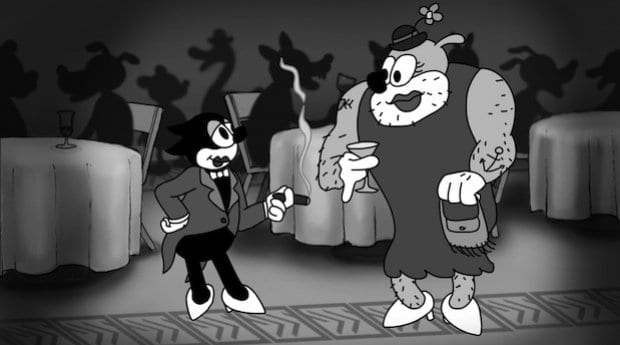The style of 1930s animation has become iconic. The wide-eyed, bouncing anthropomorphic creatures with exaggerated features and high-pitched voices immediately call to mind the era that gave us Mickey Mouse. But there was a darker side to this happy-go-lucky filmic trope; most of the popular shorts were produced under the notorious Hays Code, which placed heavy restrictions on the depiction of LGBT characters in motion pictures. They’re also known for being extremely racist, with troublingly stereotypical depictions of minorities played for laughs.
It is through this lens that lesbian filmmaker Lorelei Pepi decided to create a short that she calls a “revisionist history.” Her film, titled Happy and Gay, follows two same-sex couples out for a night on the town that takes a frightening turn when their club is raided. Along the way they deal with homophobic cab drivers, police officers and a church congregation led by a devious priest intent on marrying them to opposite-sex partners.
“Looking at that early form of cartoon, I was thinking about how my own story had been mistold,” Pepi says. “I identify with animation very deeply, and to see not explicitly myself, but the people that I am identified with represented so poorly in such negative ways . . . what I wanted to do was to say, ‘This shouldn’t be this way.’”
Pepi says she wanted to try to tell the story better. She doesn’t shy away from the stereotypical representation of LGBT people and minorities that was characteristic of 1930s animation. Rather, she uses these representations to contextualize her film. “In the context of my cartoon, I wanted to be able to be clear that this was real — that this was happening,” she says.
The resulting film will screen at the Ottawa International Animation Festival (OIAF) in mid-September as part of the international showcase. The OIAF is also screening two other shorts with LGBT content: Sandy, about a young boy who sculpts his ideal partner out of sand (also in the international showcase); and Plugin, in which citizens of a mechanical city try to find their ideal matches, in the Canadian student film competition.
Pepi says that as a lesbian filmmaker she’s always been drawn to themes around sexuality. “In the course of my interest as an artist, I found that I have tended towards issues that relate to explorations of the psyche, of the body, of sexuality [and] the relationships of how those elements fit together,” she says. “The work that I’ve done doesn’t always necessarily have that explicitly in it, but the undercurrents and tones are very clear.”
With Happy and Gay, she is exploring how the visual 1930s style works to represent the concept of sexual oppression. She was inspired by the work of animator Ub Iwerks, who worked closely with Walt Disney and was a co-creator of Mickey Mouse. In watching a collection of Iwerks’s films, Pepi noticed the recurrence of a character she describes as the “pansy” — a foppish, effeminate man who minces about the screen. The pansy makes an appearance in Pepi’s film, as do a number of other characters who poke fun at stereotypes.
At the time when Pepi was working on the short, the LGBT community in the United States was beginning to push more strongly for same-sex marriage, prompting a pushback from the conservative right and a statement from the pope condemning homosexuality and same-sex marriage. “Looking at all of these things, it was the perfect storm for me, and it made me so angry that I just needed an outlet — a way to be able to respond to the vitriol that was taking place,” she says.
The resulting film takes the anti-gay stereotypes of the 1930s and turns them on their head, using them to show gay characters in a positive light and, in the process, redeeming those who were never given a voice.
Ottawa International Animation Festival
Wed, Sept 17–Sun, Sept 21
Happy and Gay and Sandy screen as part of the International Showcase, Thurs, Sept 18, 1pm, at the National Gallery, 380 Sussex Dr; and Sat, Sept 20, 9:15pm, at Arts Court Theatre, 2 Daly Ave.
Plugin screens as part of the Canadian Student Competition, Thurs, Sept 18, 11am, at Arts Court Theatre, 2 Daly Ave; Fri, Sept 19, 11am, at the National Gallery, 308 Sussex Dr; and Sun, Sept 21, 1pm, at Arts Court Theatre, 2 Daly Ave.
For more information and to buy tickets, visit
animationfestival.ca


 Why you can trust Xtra
Why you can trust Xtra


